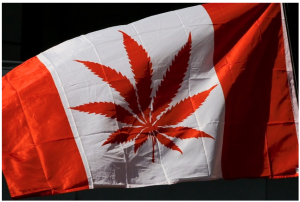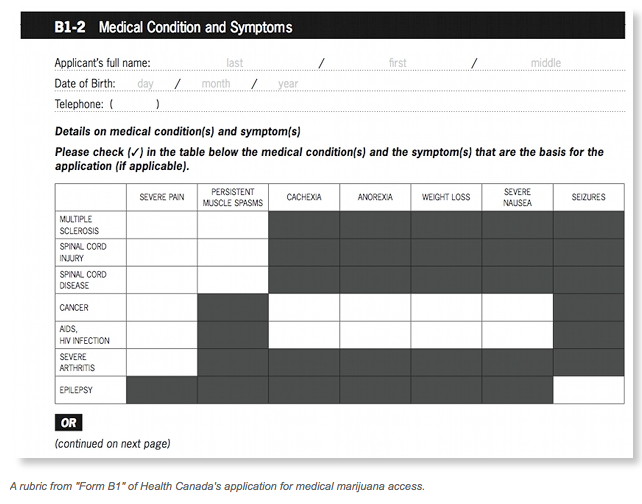On Tuesday night we learned that, because of the extreme difficulty involved in getting access to medical marijuana in Canada, an Ontario Superior Court judge had deemed provisions of the  Controlled Drugs and Substances Act that outlaw the possession and cultivation of pot unconstitutional, opening up the possibility of changes to the way Canadians use and acquire their weed. The federal government still has three months to appeal the ruling, so we won’t know the exact outcome, in all likelihood, for quite some time. But suppose Canada’s medical marijuana program were, as a result of all this, to become just about as liberalized as it could possibly get? What would that be like? For answers, we made some phone calls to California.
Controlled Drugs and Substances Act that outlaw the possession and cultivation of pot unconstitutional, opening up the possibility of changes to the way Canadians use and acquire their weed. The federal government still has three months to appeal the ruling, so we won’t know the exact outcome, in all likelihood, for quite some time. But suppose Canada’s medical marijuana program were, as a result of all this, to become just about as liberalized as it could possibly get? What would that be like? For answers, we made some phone calls to California.
California legalized marijuana for medicinal purposes in 1996, and in 2003 passed a second piece of legislation that established further protections for users and distributors. Whereas in Canada prospective medpot patients need to find a doctor willing to prescribe weed for one of a short list of Health Canada–approved diseases (or otherwise find a specialist who can vouch, in writing, for pot’s efficacy in treating a disease that isn’t listed), the standard for marijuana treatment, in the States, is a little looser.
“The baseline is standard in all 15 states that have legalized medical use. It’s a recommendation from a physician,” says Chris Hermes, a spokesperson for Americans for Safe Access, a group that advocates for legal access to medical marijuana. “Under federal law, physicians cannot prescribe medical marijuana. However, they’re protected under the first amendment, interestingly enough, to be able to recommend it.”
According to Hermes, one key difference between California’s laws and those of Canada—and even most of the 14 other U.S. states that have legalized medpot—is the lack of a firm registration requirement. Patients don’t need any kind of special dispensation from the state in order to use medical marijuana legally. California’s government requires counties to administer an ID-card program for users, but, for patients, getting the ID—a literal licence to smoke, complete with photo—is voluntary.
As a result, doctors are the final arbiters of who gets to smoke and who doesn’t. There are now medical practices that do all or most of their business in marijuana consultations.
Ezra Barth-Rogers is a manager at Compassionate Health Options, a clinic with locations in 11 California cities. “Most of our income comes from that service,” he tells me, referring to marijuana consultations—though he notes that CHO also provides basic checkups and counselling services.
“Some doctors like to spend much longer with every patient than others,” he continues. “I would say the shortest visit, for something that’s very straightforward, and the doctor has either seen the patient before, or doesn’t feel like there’s a whole lot to talk about, would be 10 minutes. And the longest visit would be 45 minutes, maybe.”
“We’re required to see people at least once a year. And we often see people two times a year. Usually not more than that.”
The setup, according to Barth-Rogers, is similar to that of any community doctor’s office. There’s a waiting room, and a clipboard with a sheet of paper upon which patients record their medical history. The difference is that at the end, they get a slip of paper that entitles them to use pot. And to get that slip, their symptoms don’t have to be all that dire.
“People can use cannabis for not only physical conditions, but also psychological conditions,” says Barth-Rogers. “A certain percentage of our patients come in for things like anxiety, insomnia. The whole gamut.”
(For a better idea of the range of complaints that might get one a marijuana recommendation, take a look at this list from another health clinic. Testicular torsion? Eczema?)
At Barth-Rogers’ clinics, consultations can cost anywhere from $90 to $150. They had to lower prices, recently, because of competition.
Once one has a recommendation in hand, it’s just a matter of finding ways to lay hands on the medicine. Patients are allowed to cultivate pot, and, more importantly, they’re allowed to share what they grow with collectives and cooperatives. This, along with a 2009 announcement by the U.S. Justice Department that it would stop busting medical marijuana facilities operating in compliance with state laws, has led to an explosion in the number of marijuana dispensaries in some parts of California.
A website called WeedMaps hosts reviews of hundreds of pot pickups across California, next to advertisements for some kind of music festival that’s being endorsed by Tommy Chong. In San Jose, where Jason Copland opened High Standards Medical Collective, his dispensary, just a few weeks ago, the local city council is considering an ordinance to cap the number of retail medpot suppliers—a number that reportedly tops 100 at the moment, though prior to 2008 it was zero.
Copland’s voice has a little bit of a western twang, which makes his analogy seem even more apt than it otherwise would: “It’s kind of the wild, wild west out here,” he says. “They’re still trying to figure out city ordinances and how they’re going to deal with the collectives.”
California cities and counties have an enormous amount of say in how dispensaries operate within their boundaries. Some parts of the state have enacted limits on numbers of licences issued to co-ops and collectives—and some places, like San Francisco and Oakland, have instituted annual licence fees. Taxing the product is also becoming popular. Copland pays an additional 7 per cent sales tax on top of the 9.25 per cent that normally applies to retail in San Jose. “They call it the cannabis tax for San Jose,” he says.
But the profit margins are still there. Copland says he saves money by growing some of his own wares. “It costs me roughly $1,000 to $1,500 a pound, to grow it, as opposed to $3,400 to $3,500 a pound buying it from a vendor.”
A high-quality eighth (that is, roughly an eighth of an ounce of dried marijuana) costs $50 at Copland’s dispensary, and so a pound sells for about $6,400. That means Copland can clear as much as $5,400, with the 7 per cent sales tax skimming off $448 for the municipality.
Adequate legal protection, both at the state and local levels, is what enables Copland and others like him to operate openly. In Ontario, by contrast, there are only a handful of dispensaries, and they function in semi-secrecy. “We’re not a legally sanctioned thing,” says David, a membership co-ordinator for Toronto Compassion Centre, a marijuana pharmacy. David didn’t give his last name, for his own protection, and TCC doesn’t list its address on its website.
David continues: “Toronto Police, if they ever did want to come into Toronto Compassion Centre, they can shut us down with any legal right. They do not even need a warrant to come in these front doors, because it’s known that this is what we’re doing. We are selling cannabis.” CALM, another Toronto dispensary, was raided last year.
Canada has a long way to go before pot is available, essentially, in stores (and not just pizza shops), but this recent legal decision at least opens the notion up for serious discussion. The levy has undoubtedly sprung a leak, and now it’s a matter of waiting to see whether legislators and the courts will plug up the stream, or whether they’ll use it to fill their bongs. Source.

